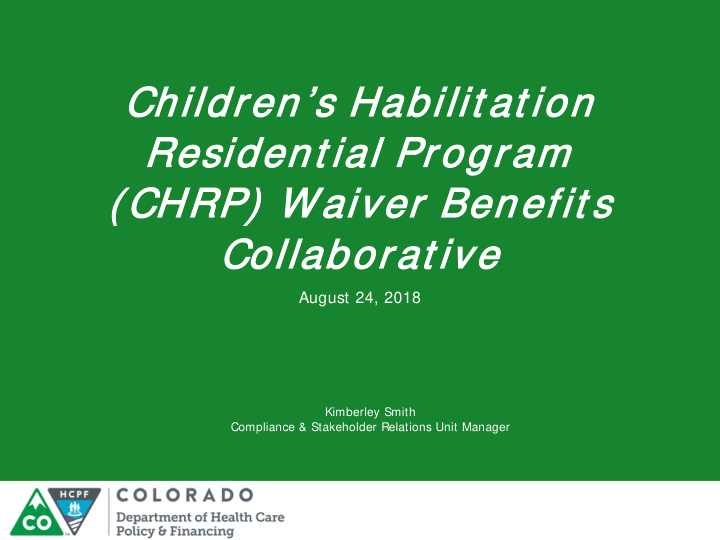



Childre ren’s Hab abilit at ion Resident ial al Prog rogram ram ( CHRP) Wai aiver r Benefit s Col ollab abora orat ive August 24, 2018 Kimberley Smith Compliance & Stakeholder Relations Unit Manager
Our Mis issio ion I mproving health care access and outcomes for the people we serve while demonstrating sound stewardship of financial resources
W hat i is t t he B Benefit s Collab llaborat at iv ive Process?
Objective Develop Benefit Coverage Policies • Subject matter experts draft a coverage policy according to evidence-based guidelines and best practices
What is a Benefit Coverage Policy? • Identifies what services are covered by Health First Colorado (Colorado’s Medicaid Program) • Defines the appropriate amount, scope and duration of a covered service • States determination of whether a given service is medically necessary • Describes the service • Lists who is eligible to provide and receive said service and where
W hat ’s M My Role H Here To Today ? ? How D Do I P Par art ic icip ipat at e?
Your Role Participants Are Consultants Your role is to provide suggestions for policy improvement based on: • Evidence based research and data • Peer reviewed literature • Knowledge of the population we serve
Guiding Principles Policy Suggestions Adopted Will : • Be guided by recent clinical research and evidence based best practices, wherever possible. • Be cost effective and establish reasonable limits upon services. • Promote the health and functioning of Medicaid clients.
Our Role • To seek out the feedback of the population we serve and those that support them. • To implement suggested improvements that meet the collaborative’s guiding principles. • To foster understanding in the community about how policy is developing, and why.
Ground Rules Participants Are Asked To: • Mind E-manners • Identify Yourself • Speak Up Here & Share The Air • Listen for Understanding • Stay Solution Focused • Stay Scope Focused
CHRP Expan ansion on Kimberley Smith – Compliance and Stakeholder Relations Unit Manager Michele Craig– Complex Needs Program Development and Evaluation Unit Supervisor
Office of Community Living Vision
The Why 1. Children in Colorado with intellectual and developmental disabilities (IDD) and complex behavioral needs must be served better. Presently, children are: Being sent out of state Served in intensive hospital settings Served by the child welfare system, when the presenting need is not an abusive or neglectful situation.
The What 2. The Department received the authority through HB 18- 1328 to expand the CHRP waiver to better serve these children. Modifications will include: Removal of requirement that the child be in foster care. Transfer of administration of the CHRP waiver from the CDHS to the Department. Transfer of case management from child welfare agencies to Case Management Agencies (specifically Community Centered Boards-CCBs). Addition of two services to the waiver to mitigate the need for an out of home placement and facilitate returns to the home once stabilized.
The What CHRP Future Health Care Policy and Financing (HCPF) CHRP Today Does not require families to relinquish custody of the child Case management specialized in IDD (Community Centered Boards and Case Management Agencies) Residential out-of-home, in- Requires families to relinquish home, and transition services custody of their child Case management not specialized for children with IDD Requires out of home placement S erves all children in abusive or neglectful situations Case management specialized in child welfare (Counties) Residential out-of-home services Child Welfare-DHS
The How and The When 1. Engage stakeholders on new benefits August-January 2019 2. Renew the waiver with CMS February-June 2019 3. Promulgate rules and regulations February-June 2019 4. Training on expanded CHRP waiver April-June 2019 5. Transition to expanded CHRP waiver February-June 2019
The Benefits Intensive In-Home Therapeutic Supports The Intensive In-Home Therapeutic Supports define strategies to support the individual and family to prevent the need for out of home placement prior to or during a family identified crisis.
The Benefits Intensive In-Home Therapeutic Supports • Crisis Mitigation Plan Development • In-Home Support • Prevention and Monitoring
The Benefits Intensive Therapeutic Transition Supports The Intensive Therapeutics Transition Supports are strategies to support the individual and family when a child transitions back to the family home from out of home placement.
The Benefits Intensive Therapeutic Transition Supports • Risk/Crisis Mitigation Plan Development • In-Home Support • Prevention and Monitoring
Questions for this group • How should “crisis” be defined? • Intensive In-Home Therapeutic Supports component services- what are we missing? • Intensive Therapeutic Transition Supports component services- what are we missing?
Questions for this group Provider Type What provider types should we consider for these services? • Provider qualifications Crisis Prevention Coordinator- align with proposed Case Management qualifications? • Direct Support Profession (In-Home Coaches)- what should qualifications be?
Next Steps
Tha hank nk you! u! Contact Information: Kimberley Smith| 303-866-3977 | kimberley.smith@state.co.us Michele Craig | 303-866-5147 | michele.craig@state.co.us
Recommend
More recommend